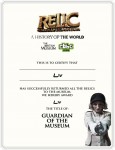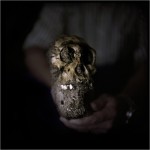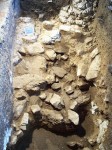Today’s Heritage Key bloggers challenge asks how we can utilize gaming technology as a learning tool for children without indulging in the sex and violence that characterize some of the more popular videogames. Is it possible to craft online virtual education which appeals to kids raised in the era of Grand Theft Auto while at the same time teaching them about history?
Short answer: yes. Long answer as follows. First I think it’s important that we unpack the assumption that sex and violence don’t belong in history teaching tools. History is replete with violence, sex and all manner of depraved intrigue, after all, so when we take it as a given that virtual education should be free of these elements, I think we do students a disservice. When we sanitize history, not only do we engage in willful deception, but we also drain it of much of its relatable humanity.
Granted, schools are notoriously twitchy about getting into the muck of things not least because parents can raise five kinds of hell about it, and no website that aspires to be educational wants to be blocked by content filters, so I wouldn’t suggest a child’s history game feature explicit sex or huge torrents of gore.
However, even Grand Theft Auto, which has become the unwitting poster child for over-the-top violence and sexually suggestive videogames, is fundamentally a mapping game with recent historical backdrops. It’s a sandbox game, so unlike linear formats that force you follow a trajectory pre-determined by the game designer, you can wander around without engaging any of the violent elements. Just pick a non-assassin, non-prostitute role and explore to your heart’s content.
I think GTA makes a better positive role model than cautionary tale for anyone seeking to create virtual historical worlds that appeal to people raised in the gamer era. Dig, if you will, the picture of an open world game set in Victorian London where you can be anyone from a chimney sweep to Jack the Ripper. Children would have every city landmark, every alley of coal-besmogged Whitechapel committed to memory within a week. How about the Tudor court? Or late Republican Rome? Or the Spanish Inquisition? Actual history is way, way juicier than Grand Theft Auto.
Rote memorization of dates and geography bores students to tears, but set up an historically accurate virtual world and give players a mission to fulfill and they’ll quaff the most arcane detail like sweetest ambrosia. That almost preternatural ability to absorb the properties of a gameworld has the potential to be an invaluable teaching tool.
Game designer Jane McGonical in this excellent TED speech about using MMORPGs to change the world points out that the average young person in game playing culture will have spent 10,000 hours gaming by age 21. With perfect attendance, a student will spend 10,080 hours from 5th grade to graduation.
That means what we’re talking about when we refer to the GTA generation is a group of people who voluntarily dedicate as much time to games as they are forced by law and/or parents to spend in school, and all those hours they are fully immersed in the game environment learning and retaining every possible nuance. So setting aside any value judgments about the quality of the learned material, which set of 10,000 hours is more productive? It’s not even a close call.
The question then becomes how do would-be educators tap into this parallel world of learning. Virtual online environments are a great way to explore cultural and historical landmarks that you can’t see in person, or which you couldn’t possibly explore in the kind of detail the virtual replica provides. They are not, however, gameworlds. There’s no complex puzzle to solve, no epic mission, no social fabric knit via collaboration, none of the elements that most engender what McGonical calls “blissful productivity,” the willingness to work hard at something deeply satisfying.
 This is where many of the games you encounter on history-themed sites fail. They tend to be afterthoughts, gadgets tacked on to content rather than fully realized gameplay environments. For example, the BBC website offers a companion game to their excellent A History of the World in 100 Objects radio series. It’s called Relic: Guardians of the Museum and the aim is to answer a multiple choice question about one of the objects in the series. If you get it right, you “unlock” the relic and return it the museum. Once you’ve unlocked them all you get (dramatic drumroll) a certificate. Please turn to your right to see my hard-won Guardian of the Museum certification.
This is where many of the games you encounter on history-themed sites fail. They tend to be afterthoughts, gadgets tacked on to content rather than fully realized gameplay environments. For example, the BBC website offers a companion game to their excellent A History of the World in 100 Objects radio series. It’s called Relic: Guardians of the Museum and the aim is to answer a multiple choice question about one of the objects in the series. If you get it right, you “unlock” the relic and return it the museum. Once you’ve unlocked them all you get (dramatic drumroll) a certificate. Please turn to your right to see my hard-won Guardian of the Museum certification.
This is not really a game so much as an open-book quiz you don’t even get graded on. I’m in no way knocking the BBC here. The series is great and the companion website marshals its readers to submit historical artifacts of their own to create a huge complex timeline of objects mundane and fantastical from all over the world. The object database is a fresh, interactive approach custom-coded to the BBC’s particular needs, but to me that only underscores the failure of game imagination that has given us Relic.
Starting with content and tacking on the shadow of something that can be mistaken for a game in the right light is backwards. To get the full advantage of the gamerbrain’s capacity to absorb knowledge, you have to do the opposite: craft a complex environment that is fleshed out with content.
Games like Making History, a World War II strategy game, are already used in classrooms. It’s not a first-person shooter like the hugely popular Call of Duty series (shooting at people in school, even fake people = not a good idea), but rather a kind of realistic CGI World War II version of Risk. Students play a country and cope with real life diplomatic and economic issues as well as military strategy.
It doesn’t sell as much as the first-person shooters — it’s a tad on the dry side — but they’ve created a legitimate gameworld that can be and is used as a teaching tool. Not that games which prominently feature historical backdrops don’t sell. Just to name a few, there’s the City Building Series, where you micromanage yourself an empire based on ancient Rome, Greece, Egypt and China, Sid Meier’s Pirates!, which embedded the map of the Caribbean in young men’s brains for 20 years, the Total War series, the Rome title of which even has a modification pack called Rome: Total Realism which corrects historical inaccuracies in the retail game, and Sid Meier’s apotheosis, the Civilization series.
Any educators seeking to entice the vast audience playing these games must realize that they are dealing with highly sophisticated gaming palates. There are no shortcuts to designing a quality game packed with challenge as well as content. This is a major challenge for any regular folk trying to create an appealing and instructive virtual history, I know. I certainly couldn’t do it, but there are people who can, and not necessarily people who cost huge gobs of cash either.
The companies that produce games with strong historical backdrops could convert them into teaching tools with a relatively small investment. All the hard and expensive development work — the creation of photorealistic historical environments like the Renaissance Florence of Assassin’s Creed II, for instance — has already been done, so add a few enthusiastic history and computer science graduate student interns to the research and development team and you could pack the existing game with historically accurate content and diverse missions at comparatively little cost. The smaller audience for educational games wouldn’t be an issue then, because the company is already making its money back from the retail game.
From a non-profit perspective, if Villanova’s Computer Science department can spend two years scanning the entire Sistine Chapel so we can explore every inch of it in extreme close-up on the Vatican website, then perhaps similar institutions and research organizations could be enlisted to design real games that enlist the full immersion capabilities of a richly detailed gameworld to educate as well as they stimulate.
 Iron Age Scots left behind a copious quantity of intricately engraved rocks. Until recently they were considered rock art or heraldic symbols, but University of Exeter professor Rob Lee has just published a study that shows Pictish carvings share some of the properties of written language.
Iron Age Scots left behind a copious quantity of intricately engraved rocks. Until recently they were considered rock art or heraldic symbols, but University of Exeter professor Rob Lee has just published a study that shows Pictish carvings share some of the properties of written language.



